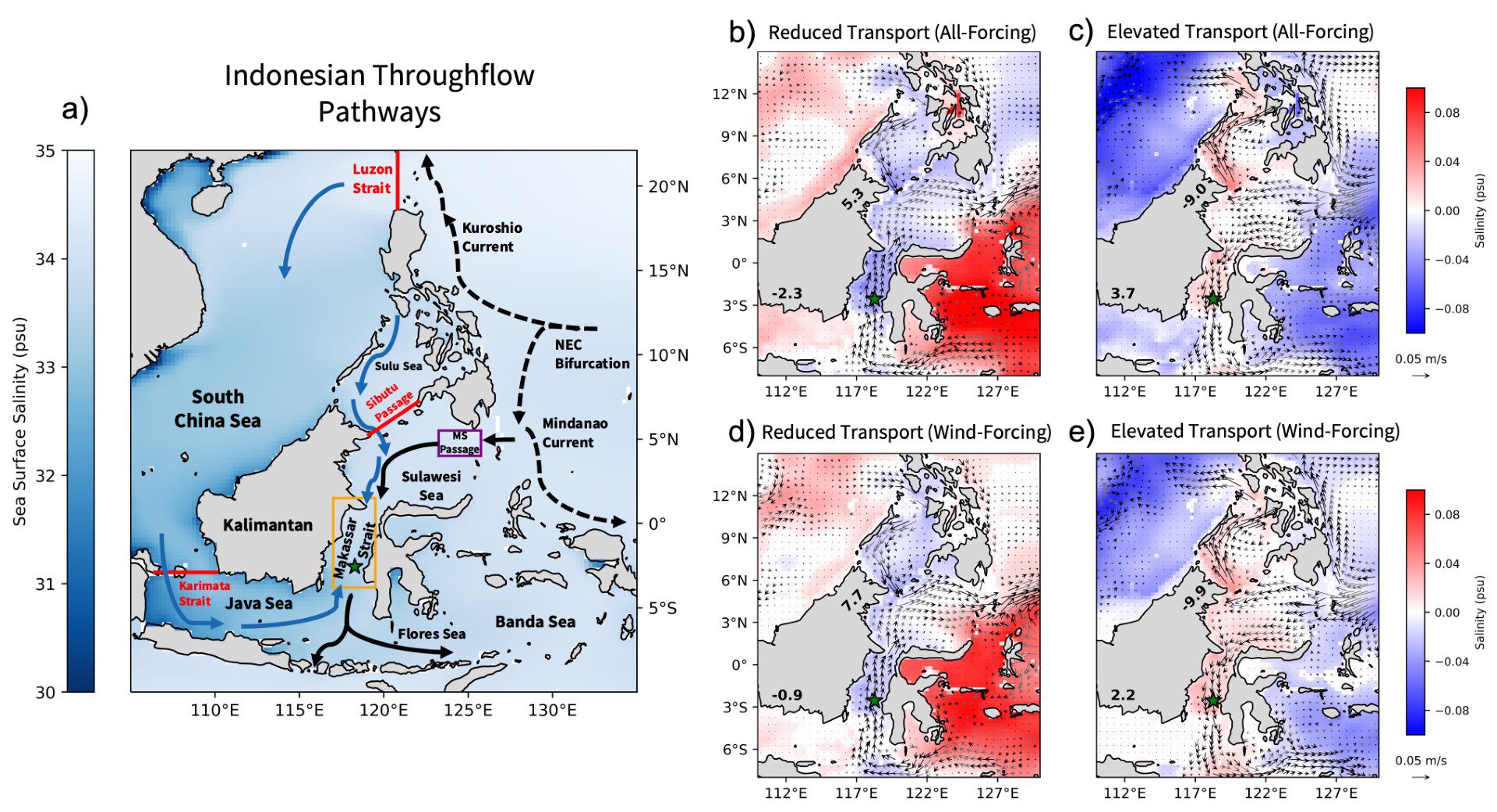Wang S, Ummenhofer CC, Oppo D, Murty SA, Wagner P, Böning CW, and Biastoch A., 2023. Freshwater contributions to decadal variability of the Indonesian Throughflow. Geophysical Research Letters, doi:10.1029/2023GL103906.

Average SSS in the Indonesian Seas (blue shading). Arrows indicate the main ITF pathway through Makassar (black solid arrows), freshwater pathways of South China Sea and Java Sea surface waters (blue arrows), and North Equatorial Current bifurcating into the Kuroshio and Mindanao boundary currents (black dashed arrows) (a). Composite maps of upper 130m average salinity (in color) and velocity (vectors) anomalies during periods of reduced (b,d) and elevated (c,e) Makassar Strait transport in the all-forcing simulation (b,c) and the wind-forcing simulation (d,e). Figure adapted from Wang et al. (2023). (Figure provided by Shouyi [Shawn] Wang)
The Indian Ocean circulation is influenced by the Indonesian Throughflow (ITF), the only low-latitude connection between two ocean basins. On average the ITF transports ~15 Sverdrups of warm, fresh waters from the western Pacific to the eastern Indian Ocean. The Makassar Strait is the main passageway of the ITF and constraining its variability is critical for understanding Indo-Pacific heat and freshwater redistribution. Previous studies utilizing in-situ observations have found that Makassar Strait surface flow (~upper 150m) varies on seasonal and interannual timescales in response to the advection of freshwater from marginal seas and local precipitation, known as the freshwater plug (Figure 1a). However, direct measurements are too short (<15 years) to resolve mechanisms of Makassar Strait transport on decadal timescales.
In Wang et al. (2023), we utilize a series of eddy-permitting global ocean simulations forced by historical atmospheric boundary conditions from 1958-2017 to assess the drivers of Makassar Strait surface transport on decadal timescales. We find that freshwater input from the South China Sea contributes to decadal variability of Makassar Strait surface flow (Figure 1b,c). Specifically, increased (decreased) freshwater transport across the Sibutu Passage weakens (strengthens) the local ITF pressure gradient and therefore reduces (elevates) Makassar Strait transport. To assess the relative contributions of wind and buoyancy (heat and freshwater flux) forcings, we analyze complementary sensitivity simulations where only one type of forcing (winds/buoyancy) is allowed to vary interannually while the other is kept at an annual cycle. We find that wind-forcings dominate the South China Sea freshwater plug on decadal timescales (Figure 1d,e).
From a broad-scale perspective, we suggest that this wind-driven freshwater input is regulated by wind-stress curl anomalies in the western North Pacific associated with Pacific decadal variability. We propose that these wind-stress curl anomalies affect the latitude of the North Equatorial Current bifurcation position, which modulates the strength of the Kuroshio Current and consequently the magnitude of South China Sea freshwater input to the Makassar Strait. Our study, which identifies a mechanism that relates North Pacific surface winds with decadal variability of a critical low-latitude inflow passage to the Indian Ocean, provides insights into the drivers of Indian Ocean heat and freshwater content variability on longer timescales.
